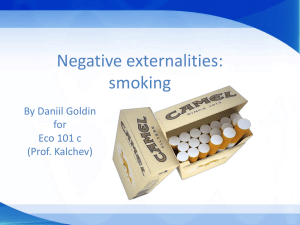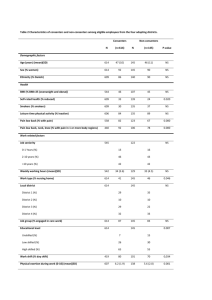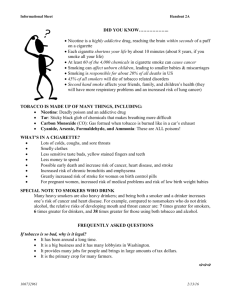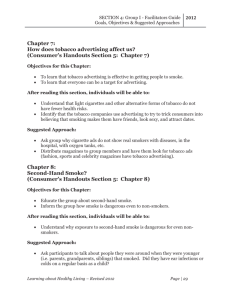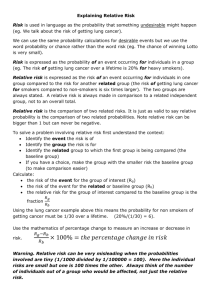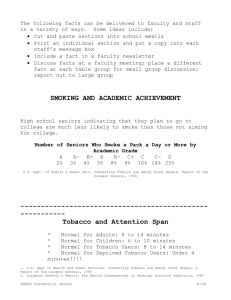Abstract: A University Tobacco Media Campaign with Messages
advertisement
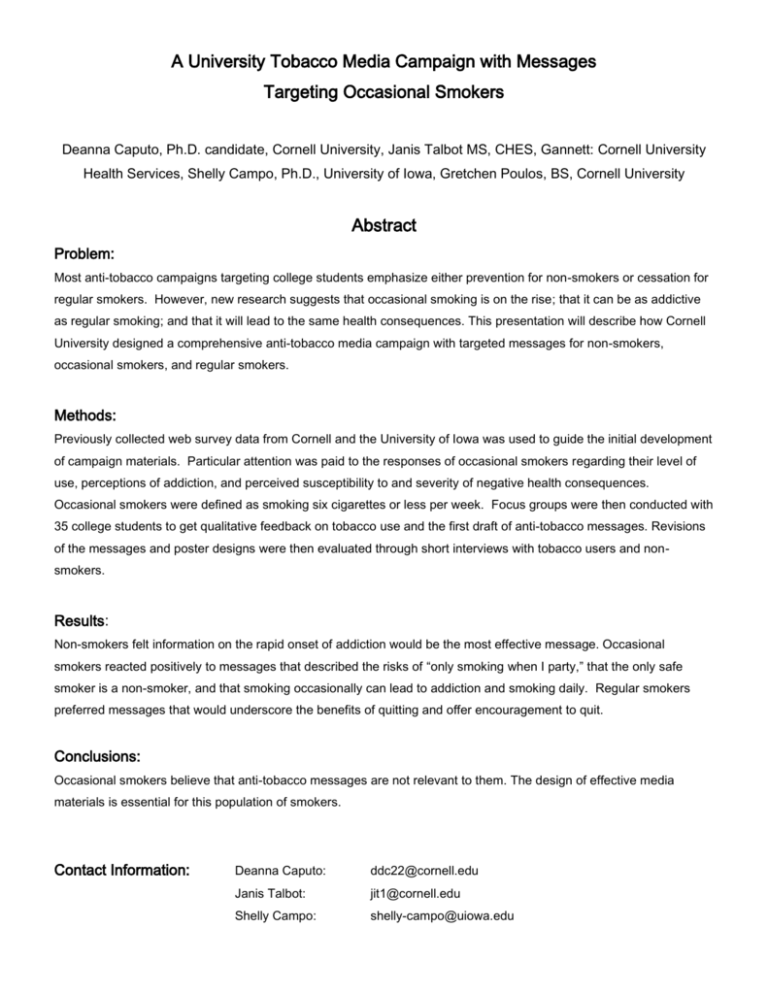
A University Tobacco Media Campaign with Messages Targeting Occasional Smokers Deanna Caputo, Ph.D. candidate, Cornell University, Janis Talbot MS, CHES, Gannett: Cornell University Health Services, Shelly Campo, Ph.D., University of Iowa, Gretchen Poulos, BS, Cornell University Abstract Problem: Most anti-tobacco campaigns targeting college students emphasize either prevention for non-smokers or cessation for regular smokers. However, new research suggests that occasional smoking is on the rise; that it can be as addictive as regular smoking; and that it will lead to the same health consequences. This presentation will describe how Cornell University designed a comprehensive anti-tobacco media campaign with targeted messages for non-smokers, occasional smokers, and regular smokers. Methods: Previously collected web survey data from Cornell and the University of Iowa was used to guide the initial development of campaign materials. Particular attention was paid to the responses of occasional smokers regarding their level of use, perceptions of addiction, and perceived susceptibility to and severity of negative health consequences. Occasional smokers were defined as smoking six cigarettes or less per week. Focus groups were then conducted with 35 college students to get qualitative feedback on tobacco use and the first draft of anti-tobacco messages. Revisions of the messages and poster designs were then evaluated through short interviews with tobacco users and nonsmokers. Results: Non-smokers felt information on the rapid onset of addiction would be the most effective message. Occasional smokers reacted positively to messages that described the risks of “only smoking when I party,” that the only safe smoker is a non-smoker, and that smoking occasionally can lead to addiction and smoking daily. Regular smokers preferred messages that would underscore the benefits of quitting and offer encouragement to quit. Conclusions: Occasional smokers believe that anti-tobacco messages are not relevant to them. The design of effective media materials is essential for this population of smokers. Contact Information: Deanna Caputo: ddc22@cornell.edu Janis Talbot: jit1@cornell.edu Shelly Campo: shelly-campo@uiowa.edu Problem • Tobacco use is on the rise among college students (Wechsler, Rigotti, Gledhill-Hoyt, & Lee, 1998). • The tobacco industry is targeting heavily college students. • Occasional use of cigarettes is on the rise nationally among the general population (MMWR, 2003) and among college students (Hines, Fretz, & Nollen, 1998). • There is a lack of educational and media materials that target college students, with proven effectiveness. A web survey was conducted at Cornell University in Fall 2002 to determine the extent of students’ tobacco use, their perceptions of addiction, their perceived susceptibility to and the severity of negative health consequences (Campo, Caputo, Talbot, & Lowe, unpublished manuscript). The goal of the survey was to learn more about students’ attitudes, perceptions, and behaviors regarding tobacco use. A stratified sample of 937 undergraduate and graduate students at Cornell completed the survey. There was an overrepresentation of men and an under representation of fraternity/sorority members in the sample. In the survey, we found the current smoking behavior of students to be: 76 % non-smokers/ experimental/ ex-smokers 19 % occasional smokers 5 % regular smokers However, when asked how they would describe their smoking status they reported: 84 % non-smokers/ experimental/ ex-smokers 9 % occasional smokers 4 % regular smokers Other survey results revealed that at Cornell: Nearly all occasional smokers did not identify as smokers. Occasional smokers were least likely to believe they could become addicted, and they believed they can quit at any time. Most everyone believed in the dangers of smoking, but the dangers of second-hand smoke were grossly underestimated. Most everyone felt that regular smokers were susceptible to the harmful effects of smoking. There was greater disagreement about the potential dangers and the susceptibility of occasional smokers. Most students felt that occasional smokers were not addicted; and to be addicted, someone must smoke an average of four cigarettes per day. Occasional and regular smokers drink more than non-smokers. All students believed that occasional smoking would: - help them deal with stress - give them a break - be enjoyable and - help with social facilitation Students greatly over-estimated the percentage of regular smokers, and somewhat over-estimated the percentage of occasional smokers. Methods Initial Development of Campaign Messages Basic Assumptions: Messages need to be tailored for occasional smokers that discuss the risk of addiction and the potential for harm. Non-smokers need their behavior reinforced, including their decision not to smoke occasionally. Regular smokers need to be reminded that there are support services available to help them quit, and that they need to set a firm date to quit. Relevant Theories: Theory of Planned Behavior (Fishbein & Ajzen, 1975: Ajzen, 1991;Ajzen & Fishbein, 1980) Transtheoretical Model of Change (Prochaska & DiClemente,1982, 1984, 1986) The Extended Parallel Process Model (Witte, 1992) Focus Groups: Participants A total of 37 students participated in four focus-group discussions: two groups with non-smokers and two with occasional smokers. Qualitative information was collected about the perceptions of non-smokers, occasional smokers, and regular smokers concerning tobacco use and health risks. Occasional smokers were considered those who reported smoking six or fewer cigarettes per week. Significant difficulty was encountered when trying to recruit regular or daily smokers to participate in the focus groups; therefore, the four focus groups consisted primarily of non-smokers and occasional smokers. It also is important to note that occasional smokers often defined themselves as non-smokers on surveys, therefore, some of the participants in non-smoker focus groups were actually occasional smokers. In addition, within the two occasional smoker groups there were participants who proclaimed, upon arrival, to be non-smokers. Therefore, all the tobacco use responses were collapsed and yielded less specific occasional smoker information than had been anticipated. Materials In each focus group, we asked questions related to smoking status, the tobacco industry, tobacco advertising, and feedback on the initial poster messages/designs. The questions designed specifically for occasional smoker perceptions and regular smoker perceptions were not all asked due to the above described difficulties with participation. Sample Focus Group Questions for Occasional Smokers: • All of you described yourself as smoking less than six cigarettes per week, when did you start and why? • How do you feel about being defined as an occasional smoker or social smoker? • Does everybody in your life know that you smoke? Who doesn’t and why? • Are there any health risks to smoking only on a weekend, or a couple days of the week? • How long do you plan to smoke occasionally? Sample Non-smoker Questions: • Ask non-smokers to complete this sentence, “Other people’s smoking really bothers me when…” • What are some of the reasons why you have chosen to NOT smoke? • At Cornell, how acceptable is it to be a non-smoker, and to ask other people to not smoke around you? • Have you ever had an experience where you had to ask someone to not smoke? How did it go? How did it feel? What would make it easier to do this the next time? • What would make you feel safer to speak out? Information, more support…? Sample Regular Smoker Questions: • Have you ever been offered free sample cigarettes or packs as a promotional tool? If so, when, where, and how? Sample Tobacco Industry Questions: • Do you think tobacco companies are being truthful when they say that smoking is not addictive? • Do you think cigarette companies try to get young people to start smoking? If so, how? If not, why not? • Do you believe that the tobacco industry has influenced your smoking habits? If so, how? If not, why not? Sample Tobacco Advertising Questions: • What tobacco messages do you remember hearing over the past year? • What is the most surprising tobacco statistic you have ever seen? Why did you remember it? All Tobacco Poster Questions: • What did you notice first about this poster? • What is the main message of this poster? • How believable is this message and why? • Who is the target audience for this poster? Who is it directed towards? • If you saw this poster on a campus bulletin board, would it catch your attention? • Would you talk to your friends about this poster and what would you say? • How would you describe this poster to a friend in your next class after seeing it? • What do you like about this poster? What changes would you make? • What do you think about the graphic design? Appealing? Interesting? Unrealistic? Boring? Interviews Second drafts of anti-tobacco messages/designs targeting occasional smokers, non-smokers, and regular smokers were evaluated through individual interviews for further student feedback. Interviews were especially effective at reaching regular smokers and more occasional smokers. Interview Questions for Each Poster Design: • How important it is that youth continue to support the tobacco industry? • What did you notice first about this poster? • What is the main message of this poster? • How believable is this message and why? • Who is the target audience for this poster? Who is it directed towards? • If you saw this poster on a campus bulletin board, would it catch your attention? • Would you talk to your friends about this poster and what would you say? • How would you describe this poster to a friend in your next class after seeing it? • What do you like about this poster? What changes would you make? • What do you think about the graphic design? • How likely do you think this poster would be in helping a smoker think about quitting? Results For Occasional Smoker Messages Focus Group Feedback (Figure 1) • Students preferred photographs to cartoon graphics. • Photographs need to reflect a “typical Cornell party scene” and people need to look like “real” students. • Disbelieved the comparison of tobacco, cocaine and heroin addictions. • Too much text to read quickly. • Liked the statistic (“50% of occasional smokers…”), but wanted to see a research source included. First Revisions (Figure 2) • Made refinements to the best liked message (“I only smoke when I party”). • Eliminated part of a sub-head. • Removed phone reference to Gannett and added a web address for information. • Replaced photo of a party scene. • Shortened text to highlight physical benefits of stopping smoking and the statistic. • Added sources for all information and a sub-head at the bottom of the poster reading “The only ‘safe’ smoker is a non smoker.” • Created a new message for piloting “I only smoke when I’m hangin' out.” Revisions Made After Interviews (Figure 3) • Pilot test of male poster showed need to revise main head to “I only smoke when I’m stressed.” Students thought the male in photo looked like he could be a Cornell student. • Removed web address as a reference and highlighted “why not quit while you’re ahead?” For Non-Smoker Messages Focus Group Feedback (Figure 4) • Students disbelieved the comparison of tobacco to cocaine and heroin addiction, and wanted to know the research source for this information. • They felt there was too much text to read. • They preferred the photo of a cigarette with smoke. First Revisions (Figure 5) • Revised text from paragraphs to make bulleted facts. • Reworded the information on addiction, and added source information as a footnote. • Left out Gannett’s phone number and added a website for information on staying smoke-free. • Removed the sentence about quitting smoking being no picnic. Revisions Made After Interviews (Figure 6) • To lower resistance to the addiction message, we added the phrase “You probably won’t believe this but…” • Reworded information on the addictive nature of nicotine to reflect most recent research conducted with adolescents. • Removed the bullet that read “on initial use…” • Revised sources to reflect changes. For Regular Smoker Messages Focus Group Feedback (Figures 7) • Students did not like cartoon illustrations or the hand illustration. • Suggested changing the text “Set a date” to “Mark your calendar.” • They suggested bulleting information to make it stand out. • They found the “breakfast” message humorous and one that related well to students. • To strengthen the breakfast message, students suggested using a regular ashtray and wanted a different coffee cup. First Revisions (Figures 8) • Reworded the sub-head “Set a Date” to read “Mark Your Calendar.” • Took two new photos for use with “Is this Breakfast?” and “Mark you calendar” posters. • Shortened the text in paragraph two, eliminated the phone number to call for help, and added a reference to Gannett and free Quit Kits. • Made the main head “Is This Breakfast?” and the sub-head “We Can Help.” • Listed advantages of quitting as bulleted items. • Eliminated reference to quitting being difficult. Revisions Made After Interviews (Figures 9) • Students liked the new photos and found they reflected their social environment. • The promotion of free Quit Kits at Gannett was seen as supportive. • Text changes improved the overall impact of the message. • Students wanted to see more color in the design and suggested highlighting certain information. Conclusions Overall Poster Feedback Students preferred poster designs that had: • Color • Real photographs versus illustrations/ animations • Photos with a cigarette in them • Positive messages • Big titles and subtitles • Bullets to list key information • Titles that related directly to the photo Students Suggested Changes: All statistics should be cited on poster ( more believable) Text in bullet format Health Office logo in small print and lighter color Bigger titles and subtitles Catchy titles and subtitles More color in text, picture and borders Researchers’ Additions: Need to appeal to all sexes. Need to reflect ethnicity of target audiences Researcher and Practical Recommendations • Commit the time and resources for this research. While this methodology may seem like a resourceheavy process, it is worth the planning time, costs and staff efforts. The process will ensure target audience acceptance, and increase your campaign’s overall effectiveness. • Focus groups were a great format for gathering this type of information because students feed off of the comments of others and this allows for a very complete evaluation of each poster. Recruiting Challenges and Recommendations Challenge 1: Identifying Occasional Smokers Recommendation: Interview Occasional Smokers One-on-One. • Alternatively, we recommend if you desire to do focus groups with occasional smokers, hold screening interviews to ensure that participants will be willing to talk about their occasional tobacco use. Subtly verify their smoking status and their willingness to talk with similar others. • Do not label occasional smokers as “smokers” in any way. Challenge 2: Recruiting Regular Smokers Recommendation: Increase Incentives and Hold One-on-One Interviews. • Offer increased incentives, and create more flexibility/availability with meeting times to ensure that facilitators are available when the group needs to meet. • Consider conducting only one-on-one interviews with smokers, as it is more confidential and there may be less resistance or defensiveness to talking about their use. This approach may allow more information to be gathered. Future Activities • Distribute campaign materials during fall 2003-spring 2004. • Evaluate effectiveness of media materials through use of focus groups, fall ’03 CORE survey, fall ’04 tobacco web survey, and a review of clinical utilization of tobacco cessation services.



